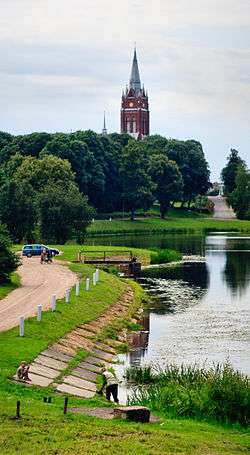Kelmė
| Kelmė | |||
|---|---|---|---|
| City | |||
|
Church of Kelmė | |||
| |||
 Kelmė Location of Kelmė | |||
| Coordinates: 55°38′0″N 22°56′0″E / 55.63333°N 22.93333°ECoordinates: 55°38′0″N 22°56′0″E / 55.63333°N 22.93333°E | |||
| Country |
| ||
| Ethnographic region | Samogitia | ||
| County | Šiauliai County | ||
| Municipality | Kelmė district municipality | ||
| Eldership | Kelmė eldership | ||
| Capital of |
Kelmė district municipality Kelmė eldership | ||
| First mentioned | 1484 | ||
| Granted city rights | 1947 | ||
| Government | |||
| • Mayor | Vaclovas Andrulis | ||
| Area | |||
| • Total | 7.85 km2 (3.03 sq mi) | ||
| Elevation | 128 m (420 ft) | ||
| Population (2011) | |||
| • Total | 9,150 | ||
| • Density | 1,200/km2 (3,000/sq mi) | ||
| Time zone | EET (UTC+2) | ||
| • Summer (DST) | EEST (UTC+3) | ||
| Website | Official website | ||
Kelmė church
Kelmė (![]() pronunciation ) is a city in central Lithuania. It has a population of 9,150 and is the administrative center of the Kelmė district municipality.
pronunciation ) is a city in central Lithuania. It has a population of 9,150 and is the administrative center of the Kelmė district municipality.
History
Kelmė's name may come from the Lithuanian "Kelmynės", literally "the stubby place" because of the forests that were there at the time of its founding.[1]
Kelmė was first mentioned in 1416, the year that Kelmė's first church was built.[1]
Prior to World War II, Kelmė (Yiddish: Kelm) was home to a famous Rabbinical College, the Kelm Talmud Torah.
According to an 1897 census, 2,710 of Kelme’s 3,914 inhabitants were members of the town’s Jewish population, the vast majority of whom were merchants and traders and lived in the town.
People
- Antanas Mackevičius[1]
- Aryeh Leib Frumkin, Rabbi
- Eliezer Gordon, Rabbi 1874–1883
- Yaakov Kamenetsky
- Elyah Lopian
- Alexander Ziskind Maimon
- Icchokas Meras, writer
- Zvi Yaakov Oppenheim, Rabbi 1883–1926
- Simcha Zissel Ziv, the Alter of Kelm
Twin towns
Kelmė is twinned with:
| City | COA | Country |
|---|---|---|
| Biłgoraj | |
|
| Hódmezővásárhely | |
|
References
External links
| Wikimedia Commons has media related to Kelmė. |
| ||||||||||||||||||||
This article is issued from Wikipedia - version of the Friday, August 21, 2015. The text is available under the Creative Commons Attribution/Share Alike but additional terms may apply for the media files.



